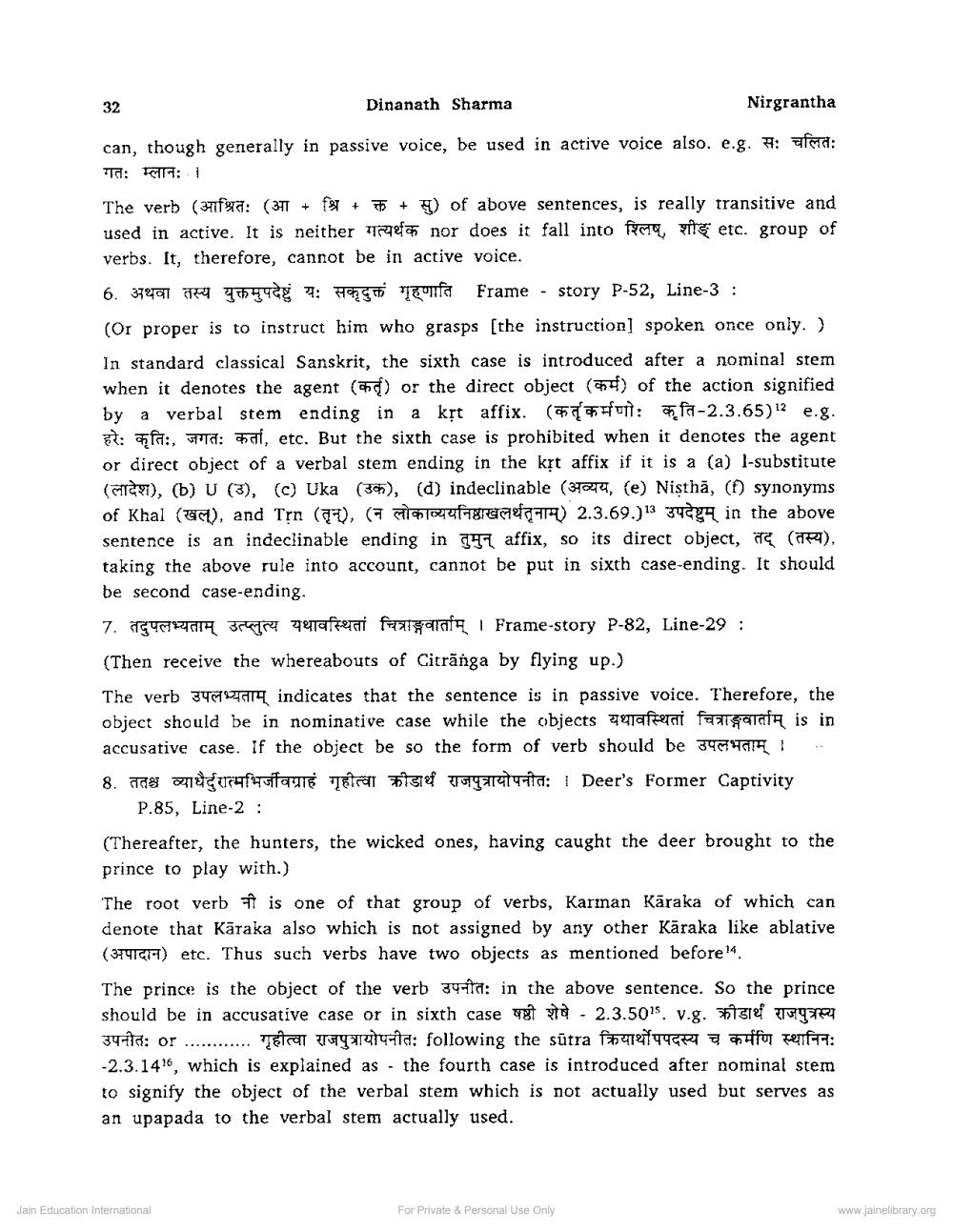Book Title: Non standard Usages in Pancatantra Author(s): Dinanath Sharma Publisher: Z_Nirgrantha_1_022701.pdf and Nirgrantha_2_022702.pdf and Nirgrantha_3_022703.pdf View full book textPage 4
________________ Dinanath Sharma Nirgrantha can, though generally in passive voice, be used in active voice also. e.g. #: afra: TG: FI: 1 The verb ( C: (371 + f + + + ) of above sentences, is really transitive and used in active. It is neither rem nor does it fall into fecta, site etc. group of verbs. It, therefore, cannot be in active voice. 6. 37401 7 1540g 7: Hog F Frame - story P-52, Line-3 : (Or proper is to instruct him who grasps (the instruction] spoken once only.) In standard classical Sanskrit, the sixth case is introduced after a nominal stem when it denotes the agent (af) or the direct object (60) of the action signified by a verbal stem ending in a křt affix. ( a f unt: fa-2.3.65)2 e.g. : fa:, fra: af, etc. But the sixth case is prohibited when it denotes the agent or direct object of a verbal stem ending in the kỉt affix if it is a (a) l-substitute (Arc), (b) U (3), (c) Uka (309), (d) indeclinable (37644, (e) Nişthă, () synonyms of Khal (art), and Trn (90, (a 4f8&STATU) 2.3.69.13 34°34 in the above sentence is an indeclinable ending in IT affix, so its direct object, (a ). taking the above rule into account, cannot be put in sixth case-ending. It should be second case-ending. 7. TG46224614 Srpu grafrei fant iaft Frame-story P-82, Line-29 : (Then receive the whereabouts of Citrānga by flying up.) The verb 346021814 indicates that the sentence is in passive voice. Therefore, the object should be in nominative case while the objects यथावस्थितां चित्राङ्गवार्ताम् is in accusative case. If the object be so the form of verb should be 3467469! ! 8. The auguraustaus Tetra pisef Tartuita: Deer's Former Captivity P.85, Line-2 : (Thereafter, the hunters, the wicked ones, having caught the deer brought to the prince to play with.) The root verb is one of that group of verbs, Karinan Kāraka of which can denote that Kāraka also which is not assigned by any other Kāraka like ablative (314619) etc. Thus such verbs have two objects as mentioned before!4. The prince is the object of the verb 34-tra: in the above sentence. So the prince should be in accusative case or in sixth case षष्ठी शेषे - 2.3.50s. v.g. क्रीडार्थ राजपुत्रस्य jutta: or ............ Metal Tyrhaita: following the sūtra f+421744627 7 for rent: -2.3.1415, which is explained as - the fourth case is introduced after nominal stem to signify the object of the verbal stem which is not actually used but serves as an upapada to the verbal stem actually used. Jain Education International Jain Education International For Private & Personal Use Only For Private & Personal Use Only www.jainelibrary.orgPage Navigation
1 2 3 4 5 6 7 8
